Effect of Laser Shock Peening on the Stress Corrosion Cracking of 304L Stainless Steel
Abstract
:1. Introduction
2. Materials and Methods
2.1. Specimen
2.2. Laser Shock Peening (LSP)
2.3. U-Bend SCC Test
- Total Crack Propagation Rate = Crack Length/Total Crack Time;
- Net Crack Propagation Rate = Crack Length/(Total Crack Time − Crack Initiation Time);
- Moreover, crack mode was observed by SEM (VEGA II LMU).
2.4. Optical Microscopic Observation
2.5. SEM-EDS and EBSD Analysis
2.6. Residual Stress Measurement
2.7. Corrosion Tests
3. Results
4. Discussion
- ①
- As shown in Figure 15, the relationship between residual stress and crack propagation rates showed a positive slope. In metallurgical aspects, when residual tensile stress reduces, stress corrosion resistance improves [4]. Therefore, as residual compressive stress by LSP increases, the crack growth rates decrease. That is, residual compressive stress by LSP is beneficial to inhibit crack growth in this case. On the other hand, based on the multiple regression analysis, the determination coefficient explains how much variance of the data is “explained” by the linear model. When the determination coefficient is over 0.65, the linear model can be generally explained, and when the correlation coefficient is over 0.7, the correlation between two parameters is strong [51]. In this case, since the determination coefficients were 0.7114~0.7548 and the correlation coefficients were 0.8434~0.8688, it is considered that the relationship between residual stress and crack growth rate is strong.
- ②
- As shown in Figure 12, the relationship between average grain size and crack propagation rates showed a positive slope. In metallurgical aspects, when average grain size refines, mechanical properties improve [52,53]. Therefore, as average grain size by LSP refines, the crack growth rates decrease. That is, grain refinement by LSP is beneficial to inhibit crack growth in this case. On the other hand, based on the multiple regression analysis, in this case, since the determination coefficients were 0.5015~0.5768, the linear relation model is somewhat explained, but the correlation coefficients were 0.7081~0.7595, so it is considered that the relationship between average grain size and crack growth rate is moderate.
- ③
- As shown in Figure 14b,b’, the relationship between pitting potential of the cross section and crack propagation rates showed a negative slope. In metallurgical aspects, when pitting potential is high, pitting corrosion resistance improves [54]. In other words, as pitting potential of the cross section by LSP increases, the crack growth rates decrease, and it means that high pitting potential by LSP is beneficial to inhibit crack growth in this case. However, based on the multiple regression analysis, in this case, since the determination coefficients were 0.3386~0.3772, the two parameters do not present a linear dependency, even though the correlation coefficients were 0.5819~0.6142 (moderate). Therefore, it is considered that the relationship between pitting potential of the cross section and crack growth rate is weak.
- ④
- As shown in Figure 13b,b’, the relationship between intergranular corrosion rate and crack propagation rates showed a negative slope. In metallurgical aspects, when IGC rate decreases, corrosion resistance improves [54]. However, as IGC rate by LSP decreases, the crack growth rate increases. In other words, it means that IGC rate by LSP is not an effective parameter for SCC resistance in this case because a low IGC rate is harmful to SCC resistance, even though there are a good determination coefficient and strong correlation coefficient between the two parameters.
- ⑤
- As shown in Figure 13a,a’, the relationship between the degree of sensitization and crack propagation rates showed a negative slope. In metallurgical aspects, when DOS decreases, corrosion resistance improves [54]. However, as DOS by LSP decreases, the crack growth rate increases. In other words, it means that DOS by LSP is not an effective parameter for SCC resistance in this case because low DOS is harmful to SCC resistance, even though there are a good determination coefficient and strong correlation coefficient between the two parameters.
- ⑥
- As shown in Figure 14a,a’, the relationship between pitting potential of the surface and crack propagation rates showed a positive slope. In metallurgical aspects, when Ep is high, pitting corrosion resistance improves [54]. However, as Ep by LSP increases, the crack growth rate increases. In other words, it means that Ep by LSP is not an effective parameter for SCC resistance in this case because high Ep is harmful to SCC resistance, even though there are a low determination coefficient and strong correlation coefficient between the two parameters.
5. Conclusions
- (1)
- Laser shock peening on 304L stainless steel induced a residual compressive stress in the depth direction and a grain refinement and an increased pitting potential of the cross section, and thus total and net crack propagation rates by the U-bend SCC test were reduced. However, based on the multiple regression analysis, the relationship between residual stress and crack propagation rates was strong, but the relationships between average grain size or pitting potential of the cross section and crack propagation rates were moderate or weak, respectively.
- (2)
- For the intergranular corrosion properties or the pitting potential of the surface peened by laser shock peening and crack growth rates, their relationships were weak in metallurgical and multiple regression analysis aspects.
Author Contributions
Funding
Institutional Review Board Statement
Informed Consent Statement
Data Availability Statement
Conflicts of Interest
References
- Lu, B.T.; Chen, Z.K.; Luo, J.L.; Patchett, B.M.; Xu, Z.H. Pitting and stress corrosion cracking behavior in welded austenitic stainless steel. Electrochim. Acta 2005, 50, 1391–1403. [Google Scholar] [CrossRef]
- Ghosh, S.; Rana, V.P.S.; Kain, V.; Mittal, V.; Baveja, S.K. Role of residual stresses induced by industrial fabrication on stress corrosion cracking susceptibility of austenitic stainless steel. Mater. Des. 2011, 32, 3823–3831. [Google Scholar] [CrossRef]
- Alyousif, O.M.; Nishimura, R. The stress corrosion cracking behavior of austenitic stainless steels in boiling magnesium chloride solution. Corros. Sci. 2007, 49, 3040–3051. [Google Scholar] [CrossRef]
- Fontana, M.G. Corrosion Engineering, 3rd ed.; McGraw-Hill Book Company: New York, NY, USA, 1987; pp. 109–139. [Google Scholar]
- Chawla, S.L.; Gupta, R.K. Materials Selection for Corrosion Control; ASM International: Novelty, OH, USA, 1993; pp. 142–143. [Google Scholar]
- Banaszkiewicz, M.; Rehmus, F.A. Stress corrosion cracking of a 60 MW steam turbine rotor. Eng. Fail. Anal. 2015, 51, 55–68. [Google Scholar] [CrossRef]
- Lopez, H.F.; Cisneros, M.M.; Mancha, H.; Garcia, O.; Perez, M.J. Grain size effects on the SCC susceptibility of a nitrogen steel in hot NaCl solutions. Corros. Sci. 2006, 48, 913–924. [Google Scholar] [CrossRef]
- Rahimi, S.; Marrow, T.J. Influence of microstructure and stress on short intergranular stress corrosion crack growth in austenitic stainless steel type 304. In Proceedings of the 17th European Conference on Fracture, Brno, Czech Republic, 2–5 September 2008; pp. 1273–1280. [Google Scholar]
- Qu, H.J.; Tao, F.; Gu, N.; Montoya, T.; Taylor, J.M.; Schaller, R.F.; Schindelholz, E.; Wharry, J.R. Crystallographic effects on transgranular chloride-induced stress corrosion crack propagation of arc welded austenitic stainless steel. Mater. Degrad. 2022, 6, 43. [Google Scholar] [CrossRef]
- Lu, J.Z.; Luo, K.Y.; Yang, D.K.; Cheng, X.N.; Hu, J.L.; Dai, F.Z.; Qi, H.; Zhang, L.; Zhong, J.S.; Wang, Q.W.; et al. Effects of laser peening on stress corrosion cracking (SCC) of ANSI 304 austenitic stainless steel. Corros. Sci. 2012, 60, 145–152. [Google Scholar] [CrossRef]
- Soyama, H.; Chighizola, C.R.; Hill, M.R. Effect of compressive residual stress introduced by cavitation peening and shot peening on the improvement of fatigue strength of stainless steel. J. Mater. Process. Technol. 2011, 288, 116877. [Google Scholar] [CrossRef]
- Azar, V.; Hashemi, B.; Yazdi, M.R. The effect of shot peening on fatigue and corrosion behavior of 316L stainless steel in Ringer’s solution. Surf. Coat. Technol. 2010, 204, 3546–3551. [Google Scholar] [CrossRef]
- Sanjurjo, P.; Rodríguez, C.; Pariente, I.F.; Belzunce, F.J.; Canteli, A.F. The influence of shot peening on the fatigue behaviour of duplex stainless steels. Procedia Eng. 2010, 2, 1539–1546. [Google Scholar] [CrossRef] [Green Version]
- Fargas, G.; Roa, J.J.; Mateo, A. Effect of shot peening on metastable austenitic stainless steels. Mater. Sci. Eng. A 2015, 641, 290–296. [Google Scholar] [CrossRef] [Green Version]
- Kim, J.H.; Lee, W.R.; Kim, T.G.; Cheong, S.K. Micro-shockwave measurement and evaluation of laser shock peening. Trans. Korean Soc. Mech. Eng. B 2011, 35, 1041–1046. [Google Scholar] [CrossRef] [Green Version]
- Kim, J.D.; Sano, Y. Laser peening application for PWR power plants. J. Weld. Join. 2016, 34, 13–18. [Google Scholar] [CrossRef]
- Sathyajith, S.; Kalainathan, S. Effect of laser peening without coating on 316L austenitic stainless steel. In Proceedings of the IOP Conference Series: Materials Science and Engineering, Kerala, India, 10–14 June 2015; Volume 73, p. 012152. [Google Scholar] [CrossRef] [Green Version]
- Hill, M.R.; Dewald, A.T.; Demma, A.G.; Hackel, L.A.; Chen, H.L.; Dane, C.B.; Specht, R.C.; Harris, F.B. Laser peening technology. Adv. Mater. Process. 2003, 8, 65–67. [Google Scholar]
- Srivastava, M.; Hloch, S.; Gubeljak, N.; Milkovic, M.; Chattopadhyaya, S.; Klich, J. Surface integrity and residual stress analysis of pulsed water jet peened stainless steel surfaces. Measurement 2019, 143, 81–92. [Google Scholar] [CrossRef]
- Jiang, W.; Luo, Y.; Wang, H.; Wang, B.Y. Effect of impact pressure on reducing the weld residual stress by water jet peening in repair weld to 304 stainless steel clad plate. J. Press. Vessel Technol. 2015, 137, 031401. [Google Scholar] [CrossRef]
- Okimura, K.; Konno, T.; Narita, M.; Ohta, T.; Toyoda, M. Reliability of water jet peening as residual stress improvement method for alloy 600 Pwscc mitigation. In Proceedings of the 16th International Conference on Nuclear Engineering, Orlando, FL, USA, 11–15 May 2008. [Google Scholar] [CrossRef]
- Amini, S.; Kariman, S.A.; Teimouri, R. The effects of ultrasonic peening on chemical corrosion behavior of aluminum 7075. Int. J. Adv. Manuf. Technol. 2017, 91, 1091–1102. [Google Scholar] [CrossRef]
- Malaki, M.; Ding, H. A review of ultrasonic peening treatment. Mater. Des. 2015, 87, 1072–1086. [Google Scholar] [CrossRef]
- Fereidooni, B.; Morovvati, M.R.; Sadough, V.S.A. Influence of severe plastic deformation on fatigue life applied by ultrasonic peening in welded pipe 316 Stainless steel joints in corrosive environment. Ultrasonics 2018, 88, 137–147. [Google Scholar] [CrossRef]
- Wang, Q.; Li, Y.; Lu, Z.; Zhang, Y.; Zou, Y. Effects of ultrasonic nanocrystal surface modification on mechanical and corrosion behavior of LZ91 Mg–Li alloy. Mater. Trans. 2020, 61, 1258–1264. [Google Scholar] [CrossRef]
- Ma, C.; Andani, M.T.; Qin, H.; Moghaddam, N.S.; Ibrahim, H.; Jahadakbar, A.; Amerinatanzi, A.; Ren, Z.; Zhang, H.; Doll, G.L.; et al. Improving surface finish and wear resistance of additive manufactured nickel-titanium by ultrasonic nano-crystal surface modification. J. Mater. Process. Technol. 2017, 249, 433–440. [Google Scholar] [CrossRef]
- Lu, J.Z.; Qi, H.; Luo, K.Y.; Luo, M.; Cheng, X.N. Corrosion behaviour of AISI 304 stainless steel subjected to massive laser shock peening impacts with different pulse energies. Corros. Sci. 2014, 80, 53–59. [Google Scholar] [CrossRef]
- Karthik, D.; Swaroop, S. Effect of laser peening on electrochemical properties of titanium stabilized 321 steel. Mater. Chem. Phys. 2017, 193, 147–155. [Google Scholar] [CrossRef]
- Kim, K.T.; Kim, Y.S. The effect of the static load in the UNSM process on the corrosion properties of alloy 600. Materials 2019, 12, 3165. [Google Scholar] [CrossRef] [PubMed] [Green Version]
- Lee, J.H.; Kim, K.T.; Pyoun, Y.S.; Kim, Y.S. Intergranular corrosion mechanism of slightly-sensitized and UNSM-treated 316L stainless steel. Corros. Sci. Technol. 2016, 15, 226–236. [Google Scholar] [CrossRef] [Green Version]
- Kim, K.T.; Lee, J.H.; Kim, Y.S. Effect of ultrasonic nano-crystal surface modification (UNSM) on the passivation behavior of aged 316L stainless steel. Materials 2017, 10, 713. [Google Scholar] [CrossRef]
- Kim, K.T.; Kim, Y.S. Effect of the amplitude in ultrasonic nano-crystalline surface modification on the corrosion properties of alloy 600. Corros. Sci. Technol. 2019, 18, 196–205. [Google Scholar] [CrossRef]
- Sadeh, S.; Malik, A. Investigation into the effects of laser shock peening as a post treatment to laser impact welding. Mater. Des. 2021, 205, 109701. [Google Scholar] [CrossRef]
- Huang, S.; Zhou, J.Z.; Sheng, J.; Lu, J.Z.; Sun, G.F.; Meng, X.K.; Zuo, L.D.; Ruan, H.Y.; Chen, H.S. Effects of laser energy on fatigue crack growth properties of 6061-T6 aluminum alloy subjected to multiple laser peening. Eng. Fract. Mech. 2013, 99, 87–100. [Google Scholar] [CrossRef]
- Gornikowska, M.R.; Kusinski, J.; Cieniek, L. Effect of laser shock peening on the microstructure and properties of the inconel 625 surface layer. J. Mater. Eng. Perform. 2020, 29, 1544–1549. [Google Scholar] [CrossRef] [Green Version]
- Yoo, Y.R.; Kim, J.S.; Kim, Y.S. Effect of laser peening on microstructural changes in GTA-welded 304L stainless steel. Materials 2022, 15, 3947. [Google Scholar] [CrossRef]
- Yoo, Y.R.; Choi, S.H.; Kim, Y.S. Effect of laser peening on the corrosion properties of 304L stainless steel. Materials 2023, 16, 804. [Google Scholar] [CrossRef]
- Gupta, R.K.; Sundar, R.; Kumar, B.S.; Ganesh, P.; Kaul, R.; Ranganathan, K.; Bindra, K.S.; Kain, V.; Oak, S.M.; Kukreja, L.M. A hybrid laser surface treatment for refurbishment of stress corrosion cracking damaged 304L stainless steel. J. Mater. Eng. Perform. 2015, 24, 2569–2576. [Google Scholar] [CrossRef]
- Irizalp, S.G.; Koroglu, B.K.; Sokol, D. Influence of laser peening with and without coating on the surface properties and stress corrosion cracking behavior of laser-welded 304 stainless steel. Metall. Mater. Trans. A 2021, 52, 3302. [Google Scholar] [CrossRef]
- Sundar, R.; Ganesh, P.; Kumar, B.S.; Gupta, R.K.; Nagpure, D.C.; Kaul, R.; Ranganathan, K.; Bindra, K.S.; Kain, V.; Oak, S.M.; et al. Mitigation of stress corrosion cracking susceptibility of machined 304L stainless steel through laser peening. J. Mater. Eng. Perform. 2016, 25, 3710. [Google Scholar] [CrossRef]
- Sano, Y.; Obata, M.; Kubo, T.; Mukai, N.; Yoda, M.; Masaki, K.; Ochi, Y. Retardation of crack initiation and growth in austenitic stainless steels by laser peening without protective coating. Mater. Sci. Eng. A 2006, 417, 334–340. [Google Scholar] [CrossRef]
- ASTM G30-2003; Standard Practice for Making and Using U-Bend Stress-Corrosion Test Specimens. ASTM International: West Conshohocken, PA, USA, 2003.
- ASTM G58-2015; Standard Practice for Preparation of Stress-Corrosion Test Specimens for Weldments. ASTM International: West Conshohocken, PA, USA, 2015.
- ASTM G36-2000; Standard Practice for Evaluating Stress-Corrosion-Cracking Resistance of Metals and Alloys in a Boiling Magnesium Chloride Solution. ASTM International: West Conshohocken, PA, USA, 2000.
- ASTM E1382; Standard Test Method for Determining Average Grain Size Using Semiautomatic and Automatic Image Analysis. ASTM International: West Conshohocken, PA, USA, 2015.
- ASTM A262-2002; Standard Practices for Detecting Susceptibility to Intergranular Attack in Austenitic Stainless Steels. ASTM International: West Conshohocken, PA, USA, 2002.
- ASTM G108-2004; Standard Test Method for Electrochemical Reactivation (EPR) for Detecting Sensitization of AISI Type 304 and 304L Stainless Steels. ASTM International: West Conshohocken, PA, USA, 2004.
- ASTM G5-2004; Standard Reference Test Method for Making Potentiostatic and Potentiodynamic Anodic Polarization Measurements. ASTM International: West Conshohocken, PA, USA, 2004.
- Turnbull, A.; Mingard, K.; Lord, J.D.; Roebuck, B.; Tice, D.R.; Motteshead, K.J.; Fairweather, N.D.; Bradbury, A.K. Sensitivity of stress corrosion cracking of stainless steel to surface machining and grinding procedure. Corros. Sci. 2011, 53, 3398–3415. [Google Scholar] [CrossRef]
- Spencer, D.T.; Edwards, M.R.; Wenman, M.R.; Tsitsios, C.; Scatigno, G.G.; Chard-Turkey, P.R. The initiation and propagation of chloride-induced transgranular stress-corrosion cracking (TGSCC) of 304L austenitic stainless steel under atmospheric conditions. Corros. Sci. 2014, 88, 76–88. [Google Scholar] [CrossRef]
- Christine, P.D.; John, R. Statistics without Maths for Psychology, 5th ed.; Prentice Hall: Lincoln, Lincolnshire, UK, 2011; p. 175. [Google Scholar]
- Dieter, G.E. Mechanical Metallurgy; McGraw-Hill Book Company: London, UK, 1988; pp. 188–191. ISBN 0-07-100406-8. [Google Scholar]
- Callister, W.D.; Rethwisch, D.G. Materials Science and Engineering, 9th ed.; John Wiley & Sons, Inc.: Hoboken, NJ, USA, 2015; pp. 266–268. ISBN 978-1-118-31922-2. [Google Scholar]
- Jones, D.A. Principles and Prevention of Corrosion; Macmillan Publishing Company: New York, NY, USA, 1992; pp. 208–220. ISBN 0-02-361215-0. [Google Scholar]
- Kim, H.P.; Choi, M.J.; Kim, S.W.; Kim, D.J.; Lim, Y.S.; Hwang, S.S. Effect of serrated grain boundary on stress corrosion cracking of Alloy 600. Nucl. Eng. Technol. 2018, 50, 1131–1137. [Google Scholar] [CrossRef]
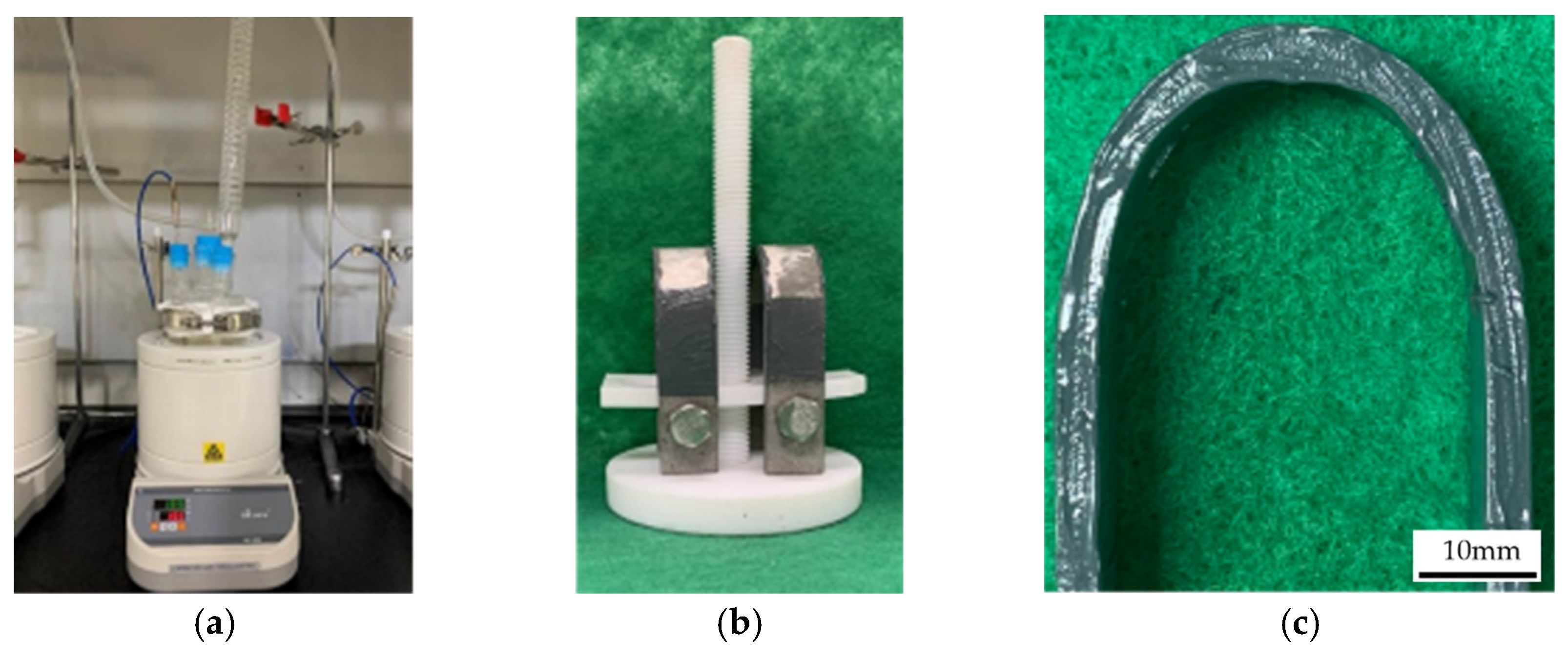
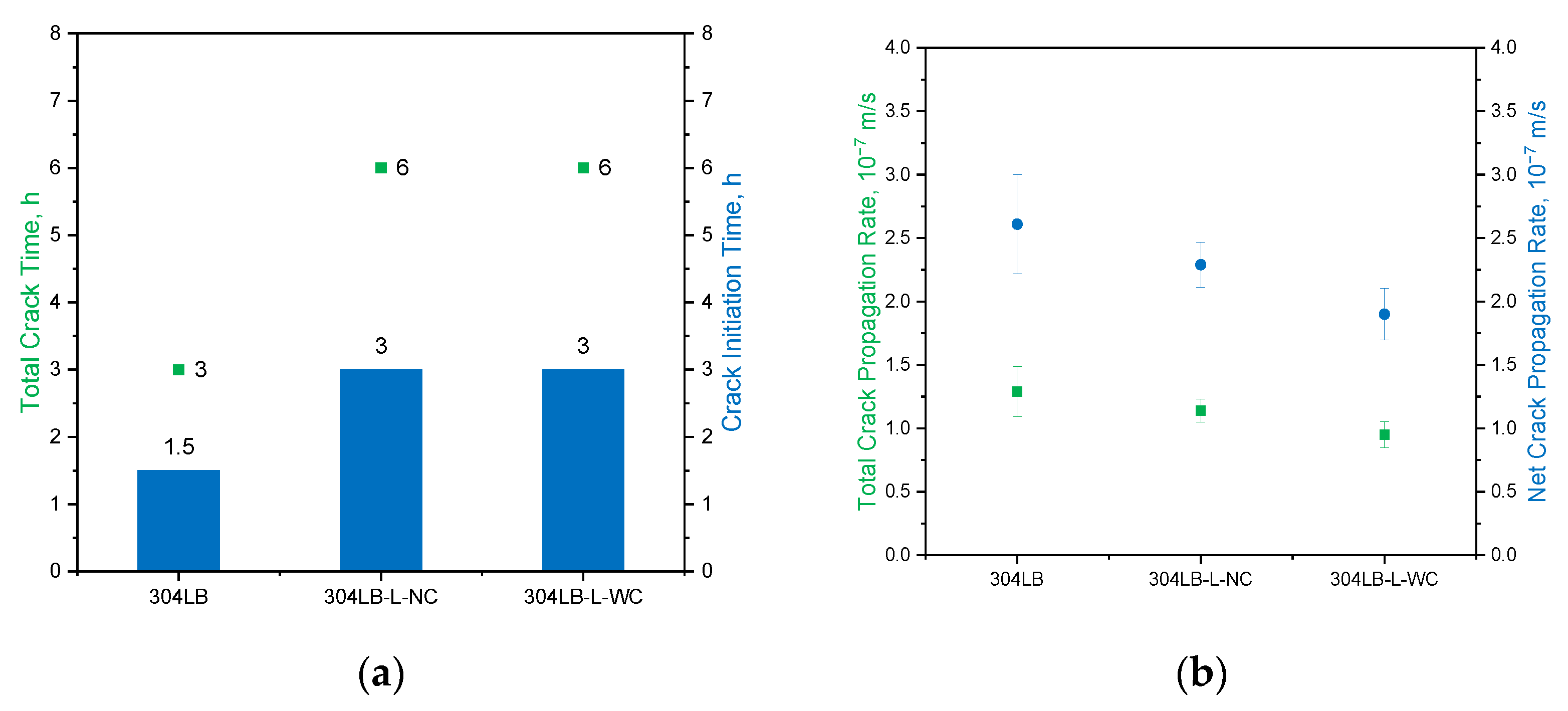



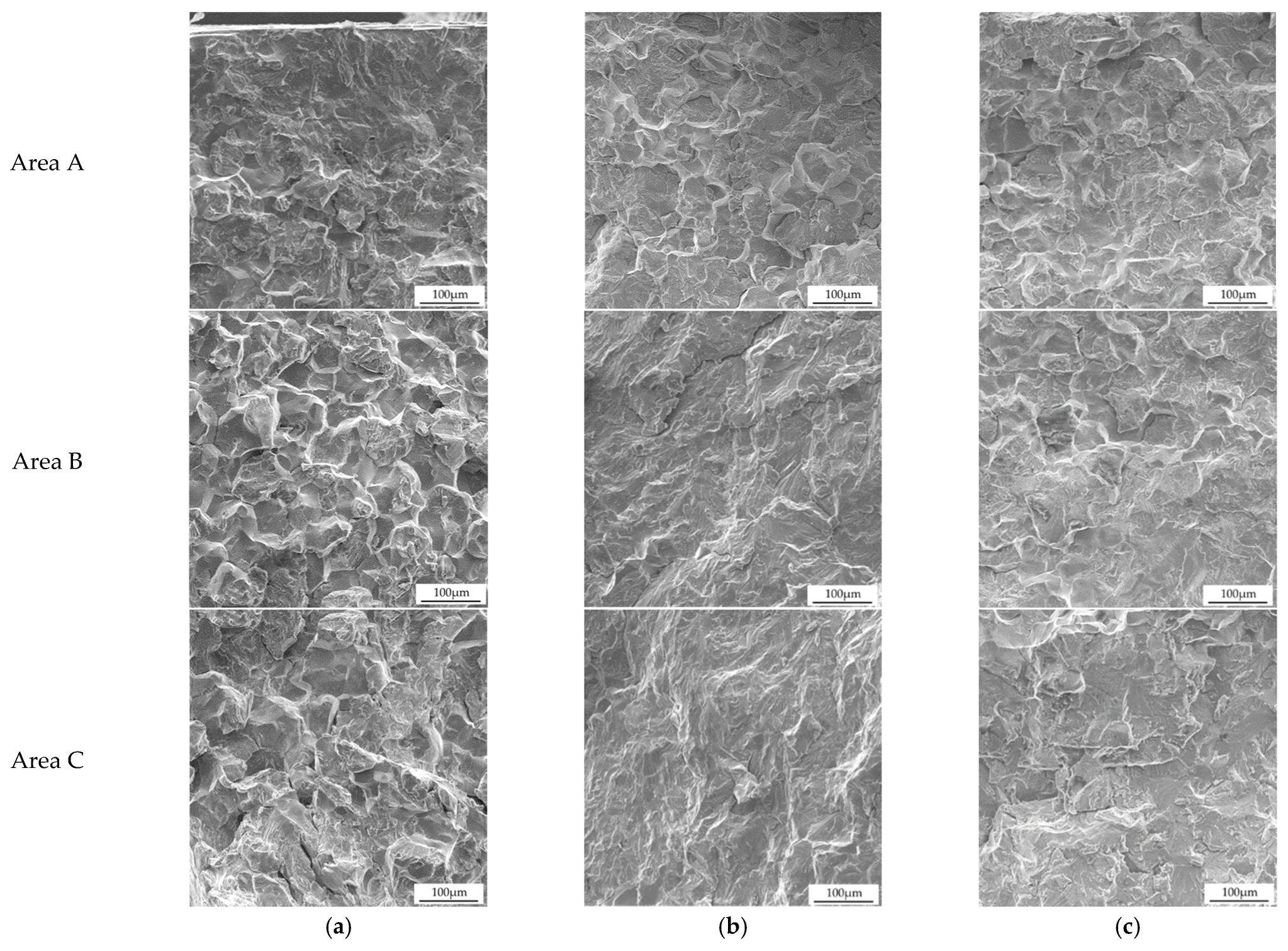
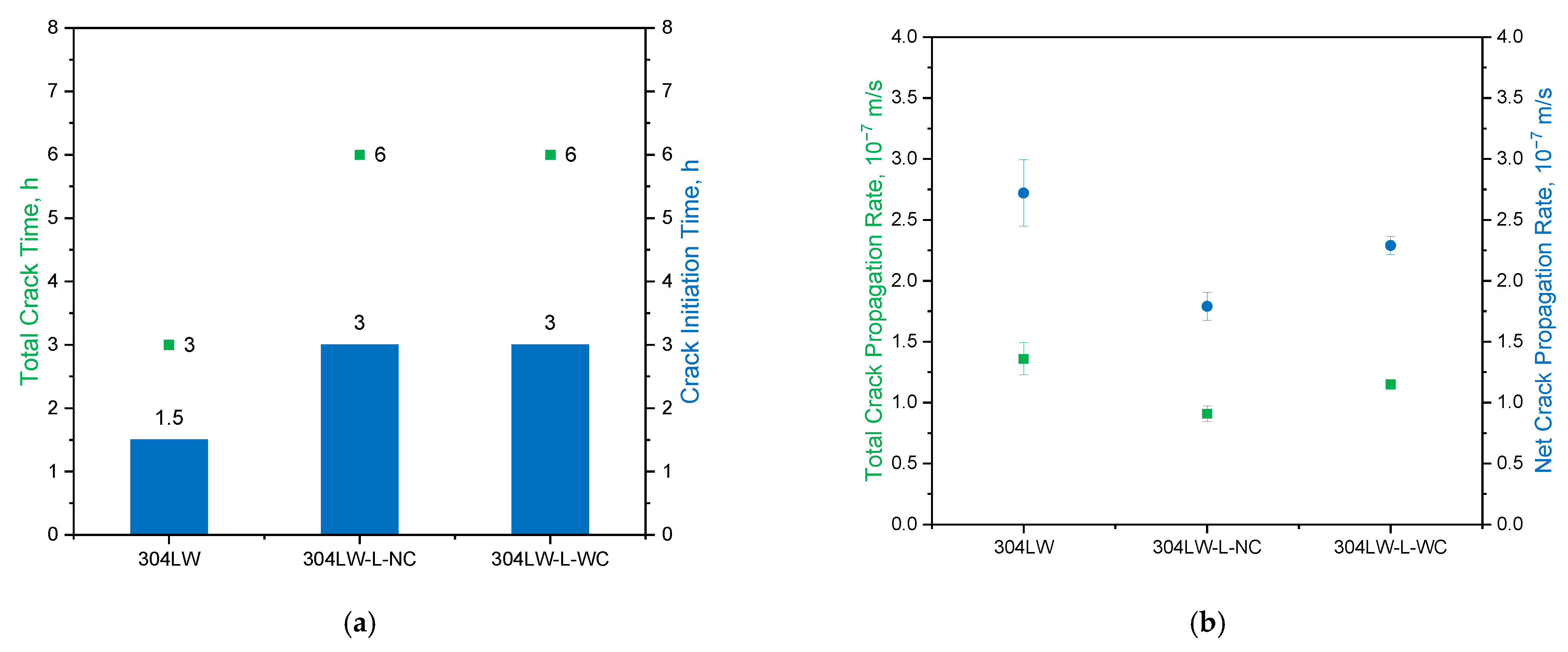
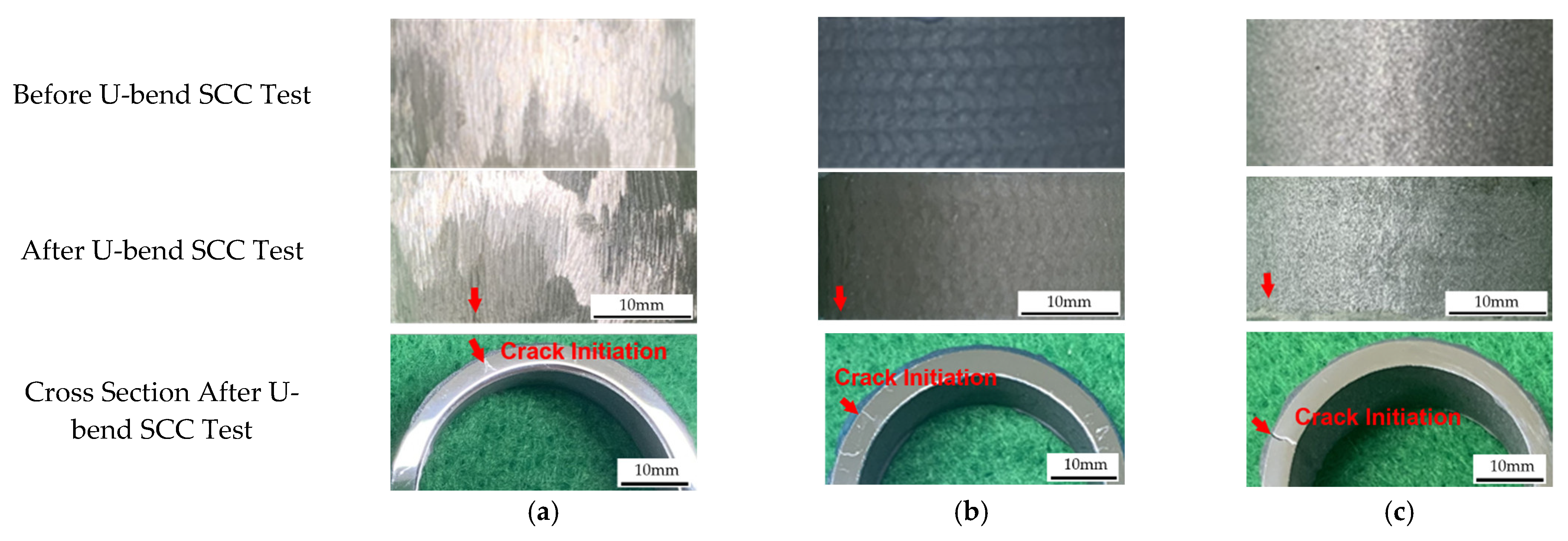
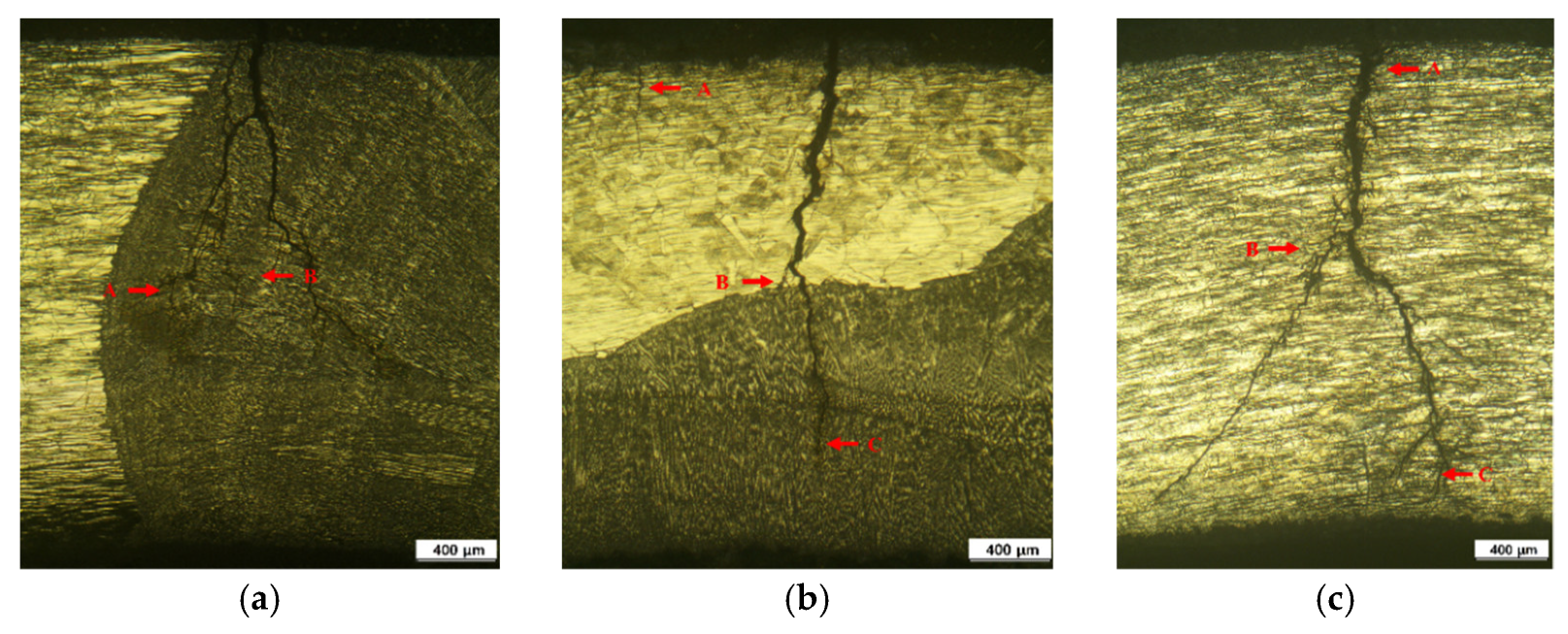




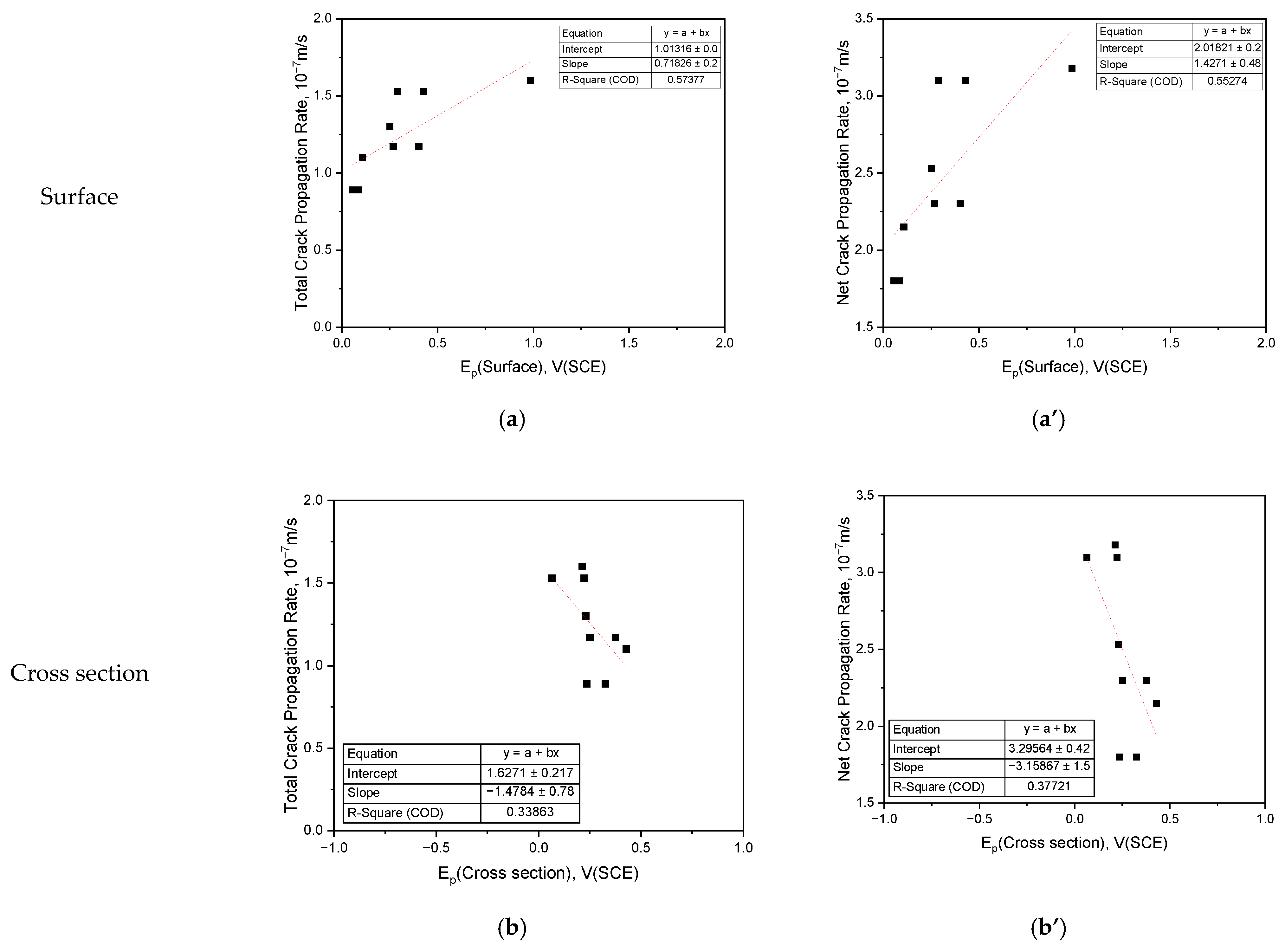



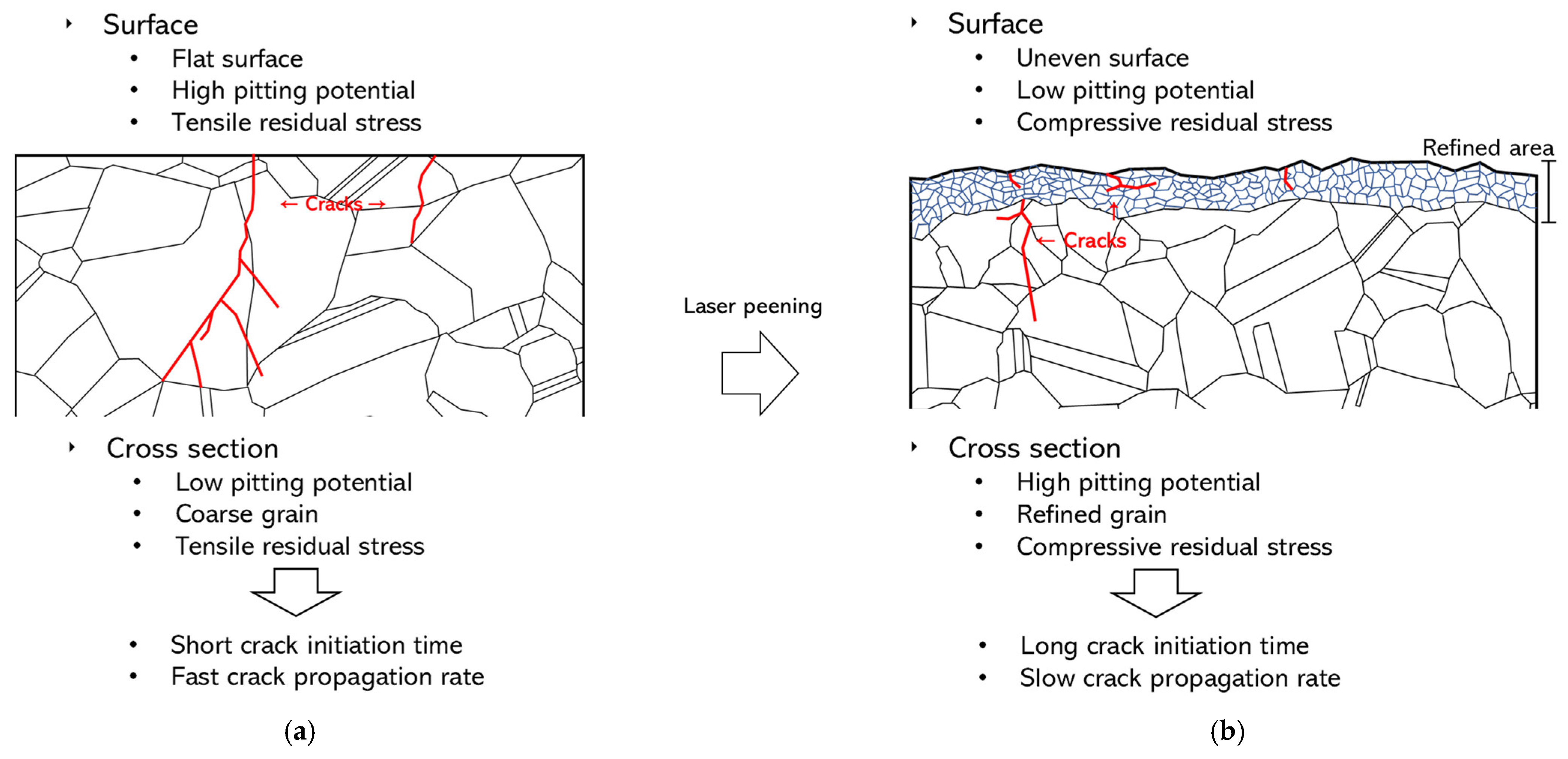
| C | Cr | Ni | Mn | Si | Cu | Mo | Co | P | N | S | Cb + Ta | Fe | |
|---|---|---|---|---|---|---|---|---|---|---|---|---|---|
| 304L | 0.02 | 18.6 | 9.6 | 1.65 | 0.47 | - | - | 0.03 | 0.022 | 0.07 | 0.03 | - | Bal. |
| ER308L | 0.015 | 19.81 | 9.84 | 1.691 | 0.351 | 0.115 | 0.046 | 0.030 | 0.024 | 0.041 | 0.03 | 0.008 | Bal. |
| Welding Process | Current (A) | Voltage (V) | Speed (cm/min) | Shield Gas (%) | Groove Angle (°) | Welding Electrode |
|---|---|---|---|---|---|---|
| GTAW | 245~250 | 14~15 | 9~10 | Ar. 99.9 | 15 | ER308L (Dia. 0.9 mm wire) |
| Alloy | Non-Peened | Laser Shock Peening | ||
|---|---|---|---|---|
| Non-Coated | With Coating | |||
| 304L | Base metal | 304LB | 304LB–L–NC | 304LB–L–WC |
| Weldment | 304LW–W | 304LW–W–L–NC | 304LW–W–L–WC | |
| Laser Type | Laser Energy (J) | Laser Spot Diameter (mm) | Laser Overlay (%) | Transparent Overlay | Laser Incident Beam Angle (°) | Coating |
|---|---|---|---|---|---|---|
| Nd-YAG * | 4.4 | 3 | 50 | Water (1~2 mm) | 18 | Al tape |
| Peening Condition | Average Grain Size, μm | DOS, Ir/Ia | IGC Rate, mm/y | Ep, V(SCE) of Surface | Ep, V(SCE) of Cross Section | |
|---|---|---|---|---|---|---|
| Non-peening | Base metal | 23.73 | 0.00003 | 0.12 | 0.985 | 0.212 |
| HAZ | 26.02 | 0.00095 | 0.20 | 0.646 | 0.222 | |
| Weldment | - | 0.00104 | 0.795 | 0.065 | ||
| LSP without Al coating | Base metal | 16.61 | 0.00641 | 0.46 | 0.250 | 0.230 |
| HAZ | 19.16 | 0.00735 | 0.46 | 0.056 | 0.235 | |
| Weldment | - | 0.00614 | 0.086 | 0.326 | ||
| LSP with Al coating | Base metal | 15.01 | 0.0002 | 0.52 | 0.107 | 0.428 |
| HAZ | 18.02 | 0.00316 | 0.30 | 0.402 | 0.250 | |
| Weldment | - | 0.00396 | 0.268 | 0.375 | ||
| Specimen | Estimated Crack Initiation Time, h | Peening Effect, % | ||
|---|---|---|---|---|
| Non-Peened | Peened (Non-Coated) | Peened (with Coating) | ||
| Base metal | 1.5 | 3 | 3 | 100 (Beneficial) |
| Welded metal | 1.5 | 3 | 3 | 100 (Beneficial) |
| Specimen | Net Crack Propagation Rate × 10−7, m/s | Peening Effect, % | ||
|---|---|---|---|---|
| Non-Peened | Peened (Non-Coated) | Peened (with Coating) | ||
| Base metal | 3.16 | 2.53 | 2.15 | −19.9~−32.0 (Beneficial) |
| Welded metal | 3.1 | 1.8 | 2.3 | −41.9~−25.8 (Beneficial) |
| Parameters vs. Crack Propagation Rates | Metallurgical Aspects | Trend Equation | Multiple Regression Analysis | Meaning in SCC Aspect by LSP | ||
|---|---|---|---|---|---|---|
| Determination Coefficient, R2 | Correlation Coefficient, R | |||||
| Residual stress | vs. Total crack propagation rate | If residual tensile stress reduces, corrosion resistance improves [4,51] | y = 1.90458x + 1.34295 | 0.7114 | 0.8434 (Strong) * | As residual compressive stress by LSP increases, the crack growth rates decrease. It means that residual compressive stress is beneficial to inhibit crack growth |
| vs. Net crack propagation rate | y = 3.97151x + 2.68338 | 0.7548 | 0.8688 (Strong) * | |||
| Grain size | vs. Total crack propagation rate | If grain refines, mechanical properties improve [52,53] | y = 0.44635x + 3.83058 | 0.5015 | 0.7081 (Strong) * | As grains by LSP refine, the crack growth rates decrease. It means that refined grain is beneficial to inhibit crack growth |
| vs. Net crack propagation rate | y = 0.96833x + 8.96696 | 0.5768 | 0.7595 (Strong) * | |||
| Ep (Cross section) | vs. Total crack propagation rate | If Ep is high, pitting corrosion resistance improves [54] | y = −1.4784x + 1.6271 | 0.3386 | 0.5819 (Moderate) * | As pitting potential of the cross section by LSP increases, the crack growth rates decrease. It means that high pitting potential is beneficial to inhibit crack growth |
| vs. Net crack propagation rate | y = −3.15867x + 3.29564 | 0.3772 | 0.6142 (Moderate) * | |||
| IGC rate | vs. Total crack propagation rate | If IGC rate decreases, intergranular corrosion resistance improves [54] | y = −0.89582x + 0.0152 | 0.6884 | 0.8297 (Strong) * | As IGC rate by LSP decreases, the crack growth rates increase. It means that IGC rate is not an effective parameter for SCC resistance because low IGC rate is harmful to SCC resistance |
| vs. Net crack propagation rate | y = −1.35319x + 1.73072 | 0.7162 | 0.8463 (Strong) * | |||
| DOS | vs. Total crack propagation rate | If DOS decreases, intergranular corrosion resistance improves [54] | y = −0.89582x + 0.0152 | 0.6569 | 0.8105 (Strong) * | As DOS by LSP decreases, the crack growth rates increase. It means that DOS is not an effective parameter for SCC resistance because low DOS is harmful to SCC resistance |
| vs. Net crack propagation rate | y = −1.80862x + 0.03035 | 0.6534 | 0.8083 (Strong) * | |||
| Ep (Surface) | vs. Total crack propagation rate | If Ep is high, pitting corrosion resistance improves [54] | y = 0.71826x + 1.01316 | 0.5738 | 0.7575 (Strong) * | As pitting potential of the surface by LSP increases, the crack growth rates increase. It means that pitting potential of the surface by LSP is not an effective parameter for SCC resistance because high pitting potential is harmful to SCC resistance |
| vs. Net crack propagation rate | y = 1.4271x + 2.01821 | 0.5527 | 0.7435 (Strong) * | |||
Disclaimer/Publisher’s Note: The statements, opinions and data contained in all publications are solely those of the individual author(s) and contributor(s) and not of MDPI and/or the editor(s). MDPI and/or the editor(s) disclaim responsibility for any injury to people or property resulting from any ideas, methods, instructions or products referred to in the content. |
© 2023 by the authors. Licensee MDPI, Basel, Switzerland. This article is an open access article distributed under the terms and conditions of the Creative Commons Attribution (CC BY) license (https://creativecommons.org/licenses/by/4.0/).
Share and Cite
Yoo, Y.-R.; Choi, S.-H.; Kim, Y.-S. Effect of Laser Shock Peening on the Stress Corrosion Cracking of 304L Stainless Steel. Metals 2023, 13, 516. https://doi.org/10.3390/met13030516
Yoo Y-R, Choi S-H, Kim Y-S. Effect of Laser Shock Peening on the Stress Corrosion Cracking of 304L Stainless Steel. Metals. 2023; 13(3):516. https://doi.org/10.3390/met13030516
Chicago/Turabian StyleYoo, Young-Ran, Seung-Heon Choi, and Young-Sik Kim. 2023. "Effect of Laser Shock Peening on the Stress Corrosion Cracking of 304L Stainless Steel" Metals 13, no. 3: 516. https://doi.org/10.3390/met13030516
APA StyleYoo, Y.-R., Choi, S.-H., & Kim, Y.-S. (2023). Effect of Laser Shock Peening on the Stress Corrosion Cracking of 304L Stainless Steel. Metals, 13(3), 516. https://doi.org/10.3390/met13030516







